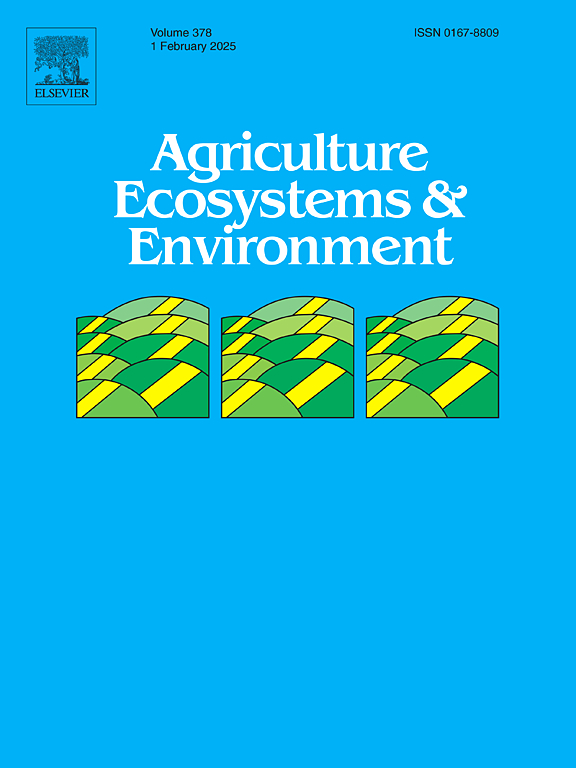西南代表性猕猴桃果园土壤健康状况综合评价
IF 6
1区 农林科学
Q1 AGRICULTURE, MULTIDISCIPLINARY
引用次数: 0
摘要
改善土壤健康对可持续农业至关重要。然而,不适当的土壤管理会威胁到土壤质量,可能会降低作物产量并损害土壤的其他功能。评估土壤健康状况,识别和改善土壤制约因素以提高作物产量对长期效益具有重要意义。然而,对多年生经济作物土壤健康的研究却很少。本研究在猕猴桃高产果园(HY;平均25.9 t ha−1),产量低(LY;平均7.0 t ha - 1),用于评估土壤健康和多功能性,并确定限制产量的主要因素。此外,还通过田间试验,考察了局部施砂对土壤物理参数的改善作用,以提高产量。土壤物理特性在HY和LY果园之间存在差异,但化学和生物特性没有差异。在0 ~ 30 cm深度,HY果园土壤孔隙度和通气孔率均高于LY果园。土壤容重和表面硬度变化趋势相反。土壤健康和多功能指数在0 ~ 30 cm深度处最高,但在不同土壤深度间差异不显著。在0 ~ 30和30 ~ 60 cm深度,HY果园土壤物理健康指标高于LY果园(分别为24 %和32 %)。结构方程模型表明,土壤表面硬度、容重和土壤通气度是制约猕猴桃产量的主要物理因素。局部施砂处理提高了土壤孔隙度、根长密度和猕猴桃产量。这些结果表明,土壤健康检测是建立果园的先决条件。土壤物理性状的修复对高粘土或高容重压实土中猕猴桃产量的优化具有重要意义。本文章由计算机程序翻译,如有差异,请以英文原文为准。
Comprehensive assessment of soil health in representative kiwifruit orchards in southwest China
Improving soil health is important for sustainable agriculture. However, inappropriate soil management threatens soil quality, potentially reducing crop yield and compromising other soil functions. Assessment of soil health, identification and amelioration of the soil constraining factors to improve crop yields are important for the long-term benefits. However, few studies on soil health in perennial cash crops have been conducted. In this study, intensive soil sampling was conducted at soil depths of 0–30, 30–60 and 60–90 cm in kiwifruit orchards with high yield (HY; average 25.9 t ha−1) and low yield (LY; average 7.0 t ha−1) in adjoining field sites to assess soil health and multifunctionality, and identify the major factors limiting yields. Additionally, a field experiment was conducted to test the effect of localized application of sand on amelioration of soil physical parameters for improving yield. Soil physical properties, but not chemical or biological properties, differed between HY and LY orchards. Soil porosity and aeration porosity at 0–30 cm deep in HY orchards were higher than in LY orchards. In contrast, soil bulk density and surface hardness had the opposite trends. Soil health and multifunctionality indices were the highest at 0–30 cm deep, but did not differ significantly between HY and LY orchards regardless of soil depth. Soil physical health indicator at 0–30 and 30–60 cm deep was higher (24 % and 32 %, respectively) in HY orchards than in LY orchards. The structural equation model indicated that soil surface hardness, bulk density and soil aeration porosity were major physical factors constraining kiwifruit yield. Soil porosity, root length density and kiwifruit yield were increased in the localized sand application treatment. These results indicate that soil health testing is a prerequisite prior to the establishment of orchards. The remediation of soil physical traits is important for optimizing kiwifruit yield in soils with high clay contents or compacted soil with high bulk density.
求助全文
通过发布文献求助,成功后即可免费获取论文全文。
去求助
来源期刊

Agriculture, Ecosystems & Environment
环境科学-环境科学
CiteScore
11.70
自引率
9.10%
发文量
392
审稿时长
26 days
期刊介绍:
Agriculture, Ecosystems and Environment publishes scientific articles dealing with the interface between agroecosystems and the natural environment, specifically how agriculture influences the environment and how changes in that environment impact agroecosystems. Preference is given to papers from experimental and observational research at the field, system or landscape level, from studies that enhance our understanding of processes using data-based biophysical modelling, and papers that bridge scientific disciplines and integrate knowledge. All papers should be placed in an international or wide comparative context.
 求助内容:
求助内容: 应助结果提醒方式:
应助结果提醒方式:


